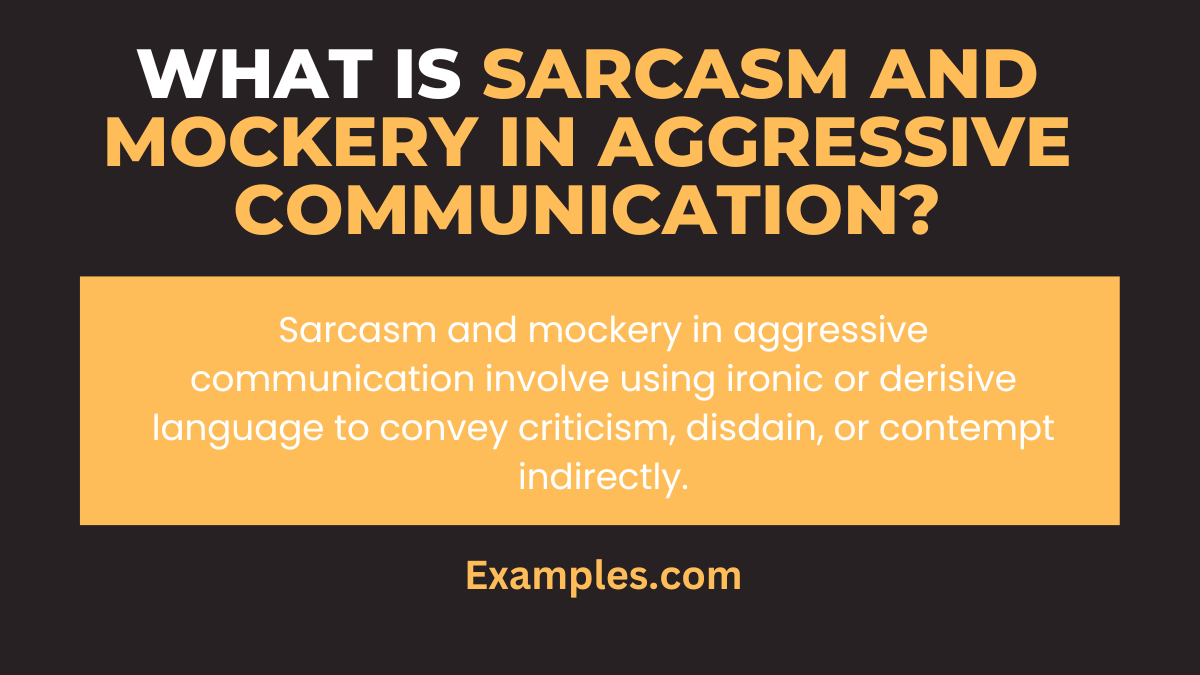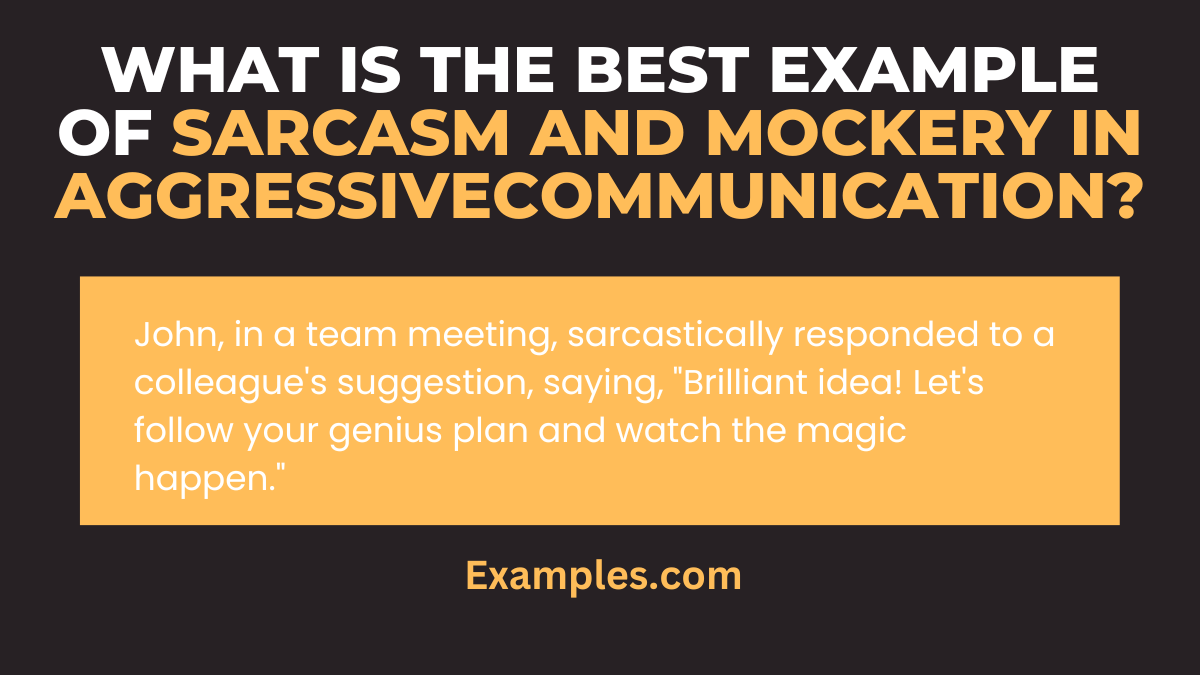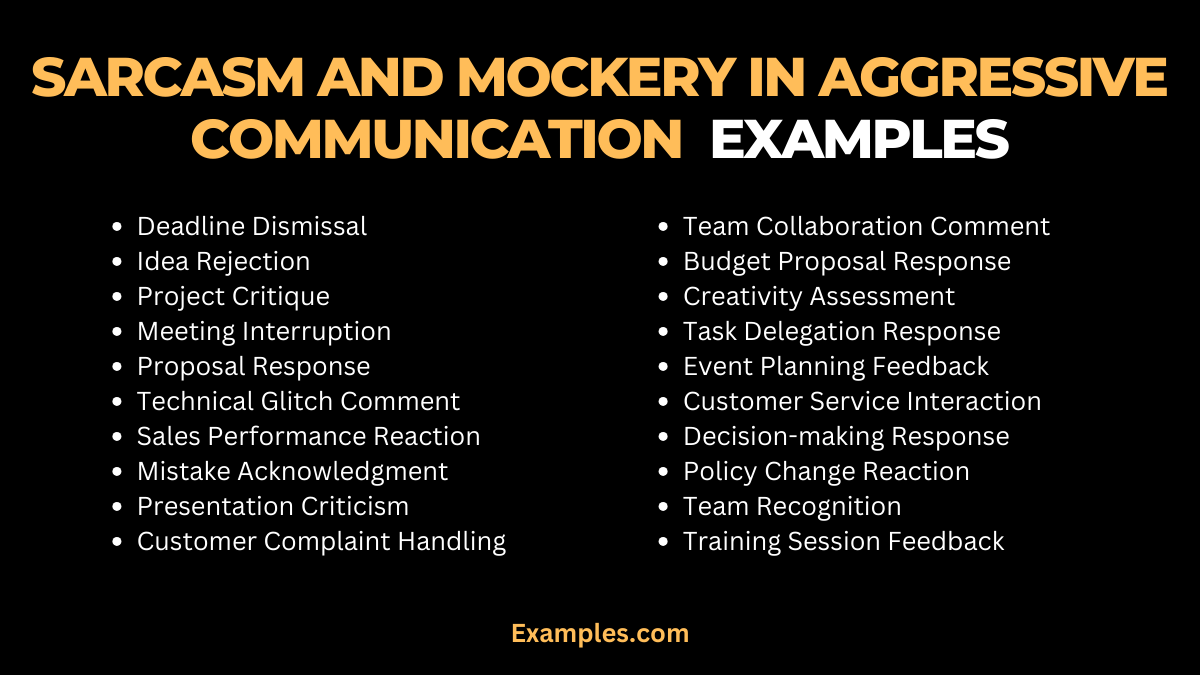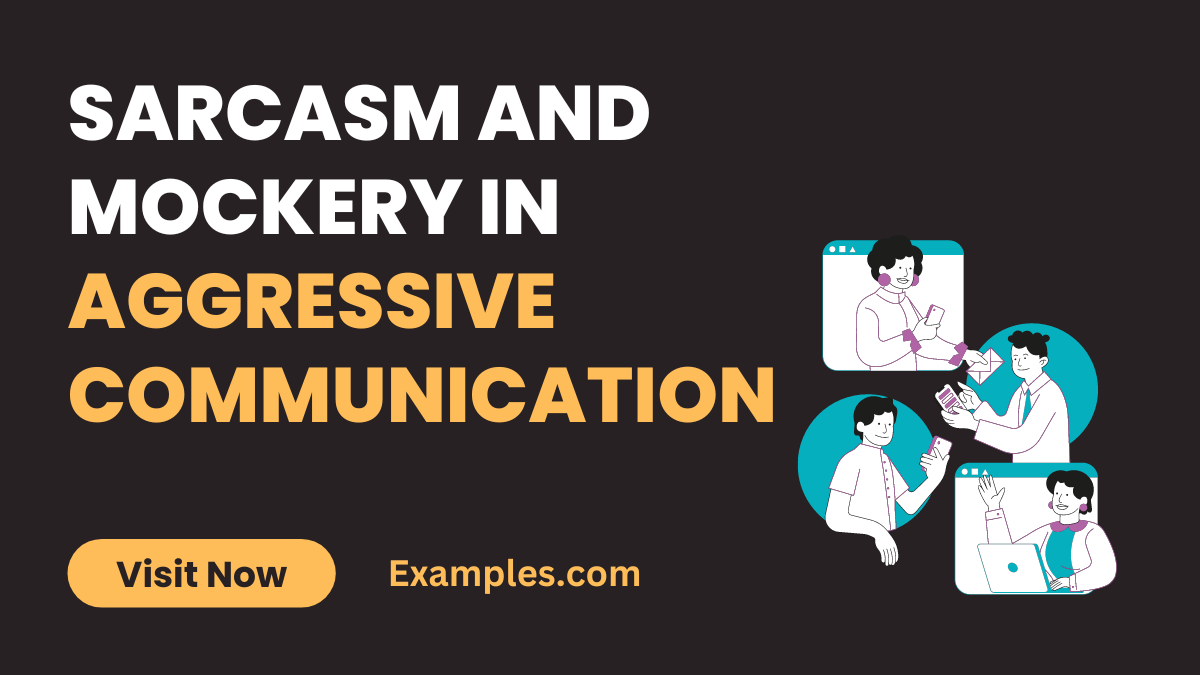19+ Sarcasm and Mockery in Aggressive Communication Examples
Embark on a nuanced exploration of Sarcasm and Mockery in Aggressive Communication. This comprehensive guide delves into the subtle interplay of words, offering insightful tips and real-world Communication Examples. Uncover strategic usage, pitfalls, and the art of balancing assertiveness, providing you with the tools to navigate this complex aspect of communication effectively. Elevate your understanding, refine your approach, and master the delicate balance between expression and impact in aggressive communication dynamics.
What is Sarcasm and Mockery in Aggressive Communication?

Sarcasm and Mockery in Aggressive Communication refer to the use of cutting or derisive remarks, often masked in humor, to convey criticism, disdain, or scorn. In this context, individuals employ sarcastic and mocking tones to assert dominance or express dissatisfaction, creating an atmosphere of hostility. Such communication can undermine relationships and foster a negative environment, highlighting the need for sensitivity and awareness in interpersonal exchanges to maintain healthy dialogue and collaboration.
What is the Best Example of Sarcasm and Mockery in Aggressive Communication?

In a team meeting, John, frustrated with a colleague’s suggestion, responded with sarcasm and mockery: “Brilliant idea! Let’s all follow your genius plan and watch the magic happen.” The disguised humor masked an aggressive tone, undermining the colleague’s input. This example illustrates how sarcasm and mockery in aggressive communication can belittle others, erode teamwork, and create a hostile atmosphere, emphasizing the need for constructive dialogue and respectful discourse.
20 Sarcasm and Mockery in Aggressive Communication Examples

Explore 20 instances exemplifying the intricate dynamics of Sarcasm and Mockery in Aggressive Communication. Each scenario offers insights into the subtle nuances of assertive expression, providing a diverse range of real-world examples to deepen your understanding of strategic communication and its potential impacts.
- Deadline Dismissal: Boldly stating, “Another missed deadline, great job!” showcased sarcasm, highlighting frustration with a colleague’s time management.
- Idea Rejection: In response to a suggestion, Sarah remarked, “Brilliant idea, as always,” dripping with sarcasm, signaling disagreement without direct confrontation.
- Project Critique: Tom’s critique, “Impressive work, if the goal was mediocrity,” used mockery to express dissatisfaction with a team member’s efforts.
- Meeting Interruption: During a presentation, Mark interjected, “Fascinating, I was almost awake,” using sarcasm to criticize the speaker’s content.
- Proposal Response: Linda responded to a proposal with, “Groundbreaking, truly,” employing mockery to convey skepticism about the feasibility of the plan.
- Technical Glitch Comment: Facing technical issues, Alex quipped, “Perfect timing, just what we needed,” using sarcasm to express irritation.
- Sales Performance Reaction: Upon hearing disappointing sales figures, Rebecca sarcastically commented, “Record-breaking, in the wrong direction,” conveying frustration.
- Mistake Acknowledgment: Dave’s response, “Congratulations on the error,” employed sarcasm to highlight disappointment with a team member’s oversight.
- Presentation Criticism: During a presentation, Chris remarked, “Truly captivating,” with evident mockery, signaling dissatisfaction with the content.
- Customer Complaint Handling: In response to a customer complaint, Emily said, “Another satisfied customer, I’m sure,” using sarcasm to address dissatisfaction.
- Team Collaboration Comment: Facing challenges in teamwork, James sarcastically noted, “Teamwork at its finest,” expressing frustration with collaboration.
- Budget Proposal Response: Upon reviewing a budget proposal, Amanda sarcastically stated, “Financial wizardry at its peak,” conveying skepticism about its viability.
- Creativity Assessment: Regarding a creative project, Mike remarked, “Truly groundbreaking,” using mockery to express disappointment with the lack of innovation.
- Task Delegation Response: When given a task, Sarah responded, “Exactly what I wanted to do,” with sarcasm, signaling displeasure with the assignment.
- Event Planning Feedback: Commenting on event plans, Jason said, “Exceptional, if you aim for chaos,” employing sarcasm to criticize the lack of organization.
- Customer Service Interaction: In a challenging customer service scenario, Lily remarked, “Exceptional service, truly,” with evident sarcasm, expressing dissatisfaction.
- Decision-making Response: Upon a team decision, Tom sarcastically remarked, “Unanimous agreement, as always,” signaling discontent with the group’s choices.
- Policy Change Reaction: Facing a policy change, Emily commented, “Innovative approach, really,” using mockery to convey skepticism about its effectiveness.
- Team Recognition: During a recognition ceremony, John said, “Another award-worthy achievement,” employing sarcasm to express disagreement with the acknowledgment.
- Training Session Feedback: In response to a training session, Laura quipped, “Truly enlightening,” with sarcasm, signaling dissatisfaction with the content.
Sarcasm and Mockery in Aggressive Communication Examples for Students
Navigate the subtleties of Sarcasm and Mockery in Aggressive Communication tailored for student interactions. This guide illuminates the impact of assertive expressions within academic settings, offering insights to enhance communication and foster a constructive learning environment.
- Class Participation Critique: In response to a student’s comment, the professor sarcastically remarked, “A profound contribution, as always,” signaling dissatisfaction with the student’s engagement.
- Group Project Evaluation: During a group project presentation, a team member used mockery, stating, “Our masterpiece, if chaos was the goal,” revealing frustration with the collaborative effort.
- Exam Performance Remark: Commenting on exam results, a classmate sarcastically said, “A stellar performance, setting new lows,” highlighting disappointment with the overall class performance.
- Late Assignment Response: A professor responded to a late submission with, “Fashionably late, as expected,” using sarcasm to address the student’s procrastination.
- Critical Feedback Session: In a peer review session, a classmate employed mockery, saying, “A literary masterpiece, if confusion was the objective,” expressing dissatisfaction with the written assignment.
Sarcasm and Mockery in Aggressive Communication Examples in Interview
Explore the nuances of Sarcasm and Mockery in Aggressive Communication within the context of job interviews. Uncover strategic examples that shed light on the impact of assertiveness during interview scenarios, providing insights for effective communication.
- Resume Critique: During a job interview, the interviewer sarcastically remarked, “An impressive resume, if fiction is your specialty,” signaling skepticism about the candidate’s qualifications.
- Skills Assessment Response: When asked about their skills, a candidate responded with mockery, stating, “Master of all trades, if the goal is mediocrity,” conveying frustration.
- Question Evasion Technique: In response to a challenging question, a candidate used sarcasm, saying, “Oh, that’s an easy one,” with evident mockery, subtly dismissing the question’s difficulty.
- Feedback on Work Experience: Discussing work experience, an interviewer sarcastically noted, “An extensive background, covering every industry,” expressing doubt about the candidate’s expertise.
- Cultural Fit Inquiry: When asked about fitting into the company culture, a candidate employed mockery, saying, “Culture fit? I invented it,” signaling confidence with a touch of sarcasm.
What Role do Sarcasm and Mockery Play in Aggressive Communication?
Sarcasm and Mockery serve as crucial tools in shaping Aggressive Communication dynamics. This guide explores their roles and offers insights for effective navigation:
- Expressive Devices: Sarcasm and Mockery act as assertive outlets, allowing indirect expression of criticism, disdain, or frustration within aggressive communication styles.
- Veiled Disapproval: These elements veil disapproval in humor, intensifying the message with dual meanings, demanding keen interpretation.
- Dominance Assertion: Sarcasm and Mockery assert dominance, showcasing superiority and challenging others within aggressive communication.
- Emotional Venting: Channels for emotional venting, they release frustration or irritation, contributing to cathartic communication dynamics.
- Undermining Authority: Within hierarchies, they subtly undermine authority by challenging statements or decisions.
How Does Sarcasm and Mockery factor into Aggressive Communication Styles?
Understanding their impact on communication styles is key to decoding nuances within Aggressive Communication:
- Passive-Aggressive Styles: Sarcasm and Mockery manifest as indirect expressions of hostility, offering subtlety to challenge without confrontation.
- Assertive Styles: Assertive communicators strategically use them to assert opinions without outright aggression, emphasizing their perspective.
- Aggressive Styles: Explicitly aggressive styles use sarcasm and mockery as direct weapons to attack and belittle, emphasizing dominance.
- Defensive Styles: Defensive communicators may resort to them as protective measures, deflecting criticism with humor to shield themselves.
- Dominance-Oriented Styles: Styles centered around dominance use sarcasm and mockery to establish superiority and challenge others.
How can one effectively Navigate Sarcasm and Mockery in Aggressive Communication situations?
Navigating situations with finesse and strategic skills is essential. Here’s a step-by-step guide:
- Cultivate Awareness: Develop heightened awareness to recognize subtle cues of sarcasm and mockery within communication.
- Decipher Intentions: Carefully decipher intentions behind their use, assessing expressions of frustration, dominance, or subtle challenges.
- Choose Responses Wisely: When faced with them, choose assertive and direct responses to address concerns without escalating aggression.
- Establish Boundaries: Clearly communicate personal boundaries, stating when certain forms, especially sarcasm and mockery, are unacceptable.
- Promote Open Dialogue: Encourage open dialogue, fostering an environment where direct expression minimizes the need for veiled tools.
- Build Assertiveness Skills: Enhance assertiveness skills for effective navigation, expressing opinions directly and reducing reliance on indirect tools.
- Seek Mediation if Necessary: If situations escalate, seek mediation for constructive dialogue, fostering resolution and minimizing aggressive impact.
- Reflect and Learn: Reflect on experiences, learning from interactions to enhance communication and mitigate potential conflicts in the future.
In conclusion, Sarcasm and Mockery wield significant influence in shaping Aggressive Communication dynamics. Understanding their roles and impact on communication styles is vital for effective navigation. By cultivating awareness, choosing responses wisely, and promoting open dialogue, individuals can navigate these nuanced tools, fostering constructive communication and minimizing potential conflicts. This guide serves as a comprehensive resource for those seeking insights into the complex interplay of sarcasm and mockery within aggressive communication.



